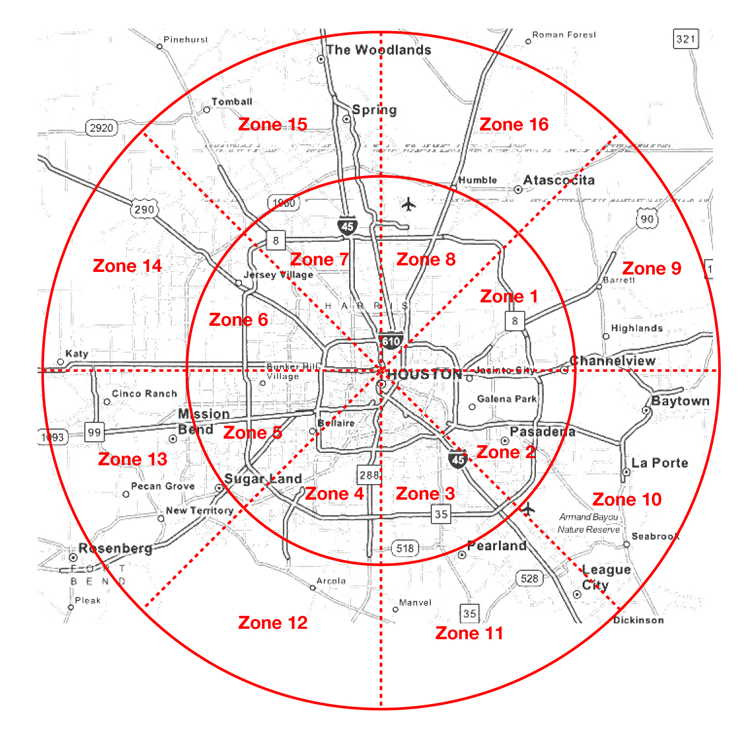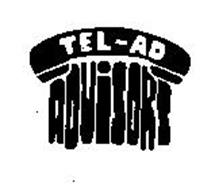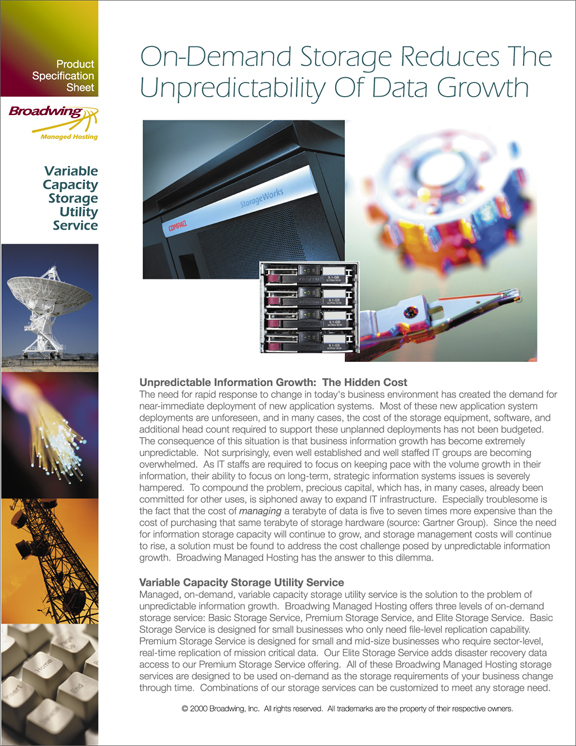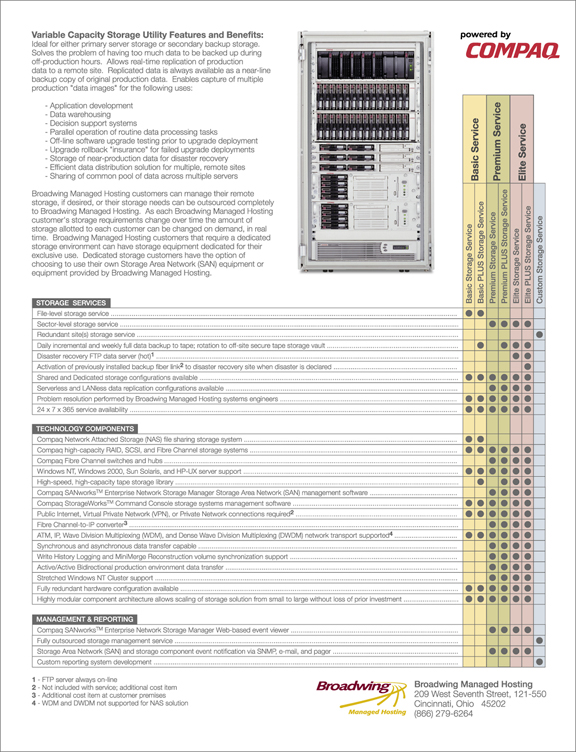Marketing Experience
I Understand How To Understand Customers
Marketing is the process by which businesses understand their customers’ needs in order to develop high-value products and services that satisfy those needs with a competitive advantage. I understand the marketing process intimately and have used it extensively to support my selling activities (see Sales Experience) and my career success.
Identifying business opportunities, defining customer types, developing product and service concepts, establishing the value of each concept for each customer type, and promoting the value of each concept to create new customers defines the process we know today as “marketing.” There are a limitless number of activities that define marketing. Each activity supports the tactical goal of matching products and services with customer need to produce a sale. I have personally created, managed, and participated in almost every traditional marketing activity during my career. In the following paragraphs I describe some of the marketing experiences for which I was responsible that produced significant innovative business results.
Tel-Ad – Where Are The Prospects and How Much Are They Worth?
It’s the early 1980s in Houston, TX. The city is experiencing incredible growth and I pioneer the use of wire center marketing to solve a significant business problem. As the President of Tel-Ad Advisors Southwest, Inc. I’m responsible for ensuring that each member of my sales team can present our sales message four times per day in pre-set appointments generated by our telemarketing team. The problem we are having is the infamous Houston traffic and our inability to schedule appointments for each sales rep in a specific area of the city each day. Appointments are being scheduled at all points on the compass and the sales reps can’t get from one appointment to the next in time because of congested traffic. We are having to reschedule missed appointments which is significantly slowing our sales volume.
Somehow we had to find a way to group appointments by geography. We were in the business of consulting with small-and-medium-sized businesses about how best to utilize their limited Yellow Pages advertising dollars. It occurred to me that the solution to our problem was right in front of me. Every phone number in the United States begins with an area code and a three-digit prefix. The prefix associates each phone number with a unique telephone company Central Office (CO) that serves a specific geographic area. If I could understand which geography each CO served, I could group multiple prefixes into geographic areas that would enable each sales rep to work a specific area of Houston each day. This would solve the problem of missed appointments and slowed sales volume.
Luckily for us every telephone company maintains a service map for each CO which shows the geography it serves. Telephone companies group multiple COs into what are referred to as “exchange maps” that show all of the COs that comprise an exchange. “Exchange” is telephone parlance for “prefix.” I obtained the exchange maps from Southwestern Bell Telephone and grouped multiple prefixes into sixteen Marketing Zones. This provided the telemarketing team with the ability to target specific Zones as they scheduled appointments. I also divided the Houston geography into two rings – a “close-in ring” and a “suburb ring.” This enabled sales reps to more effectively plan their travel time to and from their work area each day.
A significant by-product of this marketing effort was the ability to understand where the highest-value prospects were located. The computer program that I wrote and that was used by my administrative staff to quantify the location of each prospect also quantified their potential sales value. This gave us the ability to target the most valuable prospects early in a sales campaign, a tactic that increased our sales volume by 25%. Missed appointments declined by 50% and sales reps commissions increased significantly, which made everyone happy. Today wire center marketing is an established tool that is used to identify which telephone prefixes in a given geography correlate with specific demographic data (e.g., household wealth, business revenue, etc.). In the early 1980s it was an innovative and pioneering use of telephone company data that hadn’t yet been discovered by mainstream marketers.
Broadwing – Branding A New Company and A Complex Service Product
In early 2000, five years after the dawn of the World Wide Web (www), Cincinnati Bell Telephone Company is launching new Web business units via its business incubator, Zoomtown.com. One of these business units is founded to provide business telephone subscribers with the hardware, software, and support services upon which they can build their commercial Web sites. The thinking is that existing business telephone customers are more likely to buy Web hosting services from their long-established telephone company than new, untried Web hosting startups.
I am responsible for marketing and business development. One of my challenges is to brand the complex Web hosting services that we provide to our customers. We have a very compelling story to tell (the actor Dennis Hopper was our television advertising spokesperson). Cincinnati Bell Telephone had recently formed their Broadwing Communications business unit after purchasing IXC Communications’ 17,000 mile national fiber optic network. My business unit, Broadwing Managed Hosting, is being incubated by Zoomtown.com. Our services are being sold by a combination of Broadwing Communications and Broadwing Managed Hosting sales staff. I have a wide and varied audience to whom I need to communicate both the Broadwing Communications brand and the range of services offered by Broadwing Managed Hosting.
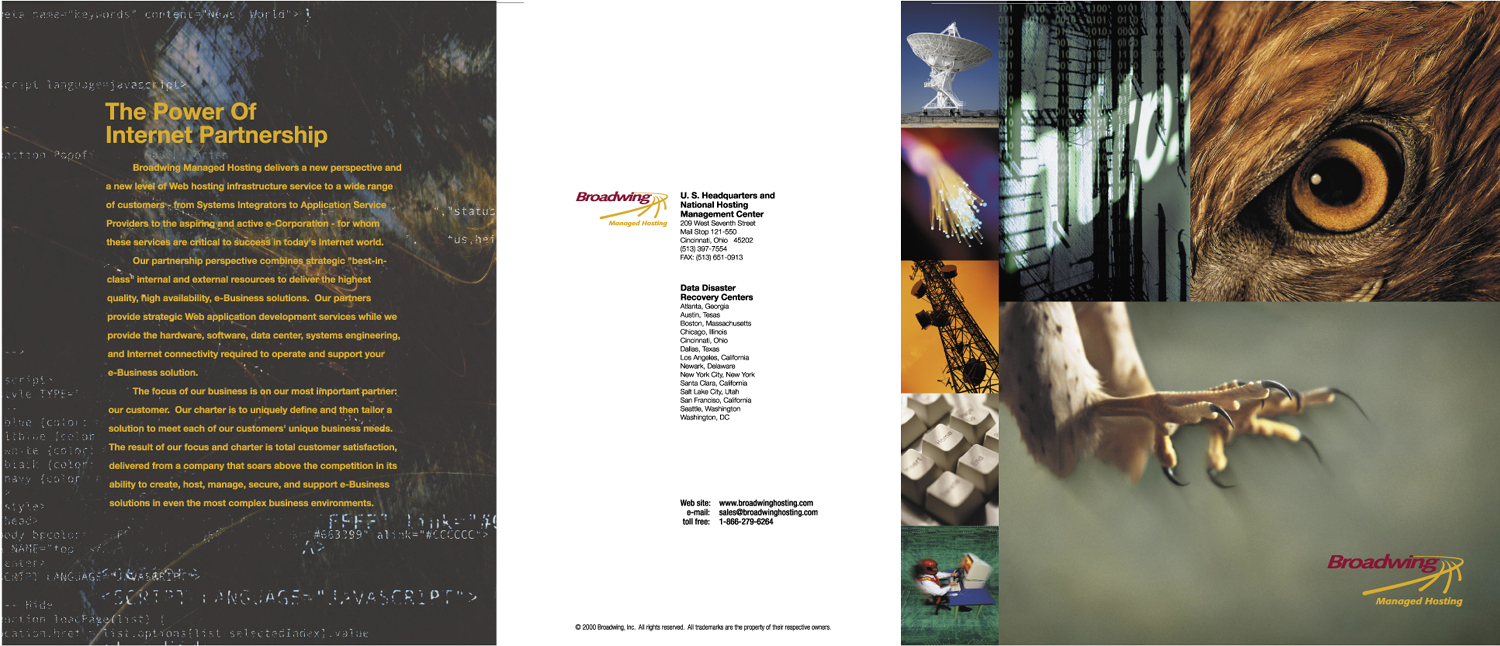 Broadwing Pocket Folder – Outside (click to enlarge)
Broadwing Pocket Folder – Outside (click to enlarge)
![Broadwing Pocket Folder - Inside - [CS-I RGB 150 W 1500 x 670]](http://www.wgvallance.com/WGV01/wp-content/uploads/Broadwing-Pocket-Folder-Inside-CS-I-RGB-150-W-1500-x-670.jpg) Broadwing Pocket Folder – Inside (click to enlarge)
Broadwing Pocket Folder – Inside (click to enlarge)
The solution is a full-color pocket folder with individual product data sheets. The concept is to present the Broadwing brand on the outside of the pocket folder and the Broadwing Managed Hosting story on the inside of the pocket folder. Individual product data sheets are placed into the pocket (which is located on the inside of the folder) to enable the Broadwing sales team to fine-tune their “literature message” to each customer’s specific interests. This avoids “literature overload” and the loss of customer focus on the solution being proposed by the sales team.
Working with the Broadwing Managed Hosting leadership team and Broadwing Communications I formulated the messaging that would be used to commmunicate both the Broadwing brand and the Broadwing Managed Hosting service offerings. I did this through a combination of market research and face-to-face interviews. These interviews included obtaining the branding guidelines used by Broadwing Communications. This was a critical part of the messaging that would both establish the identity of Broadwing Communications and link Broadwing Managed Hosting as a business unit of Broadwing Communications.
Once the messaging and brand identity had been established I began the process of creating the pocket folder and each of the ten product data sheets. I designed the pocket folder and each product data sheet using Adobe Illustrator. I shot the building and data center photography and used stock photos where needed. I used Adobe Photoshop to process photography. I wrote the copy using the messaging that had been developed during my research and interviews as a guide. I produced a pre-press color proof using Adobe’s PressReady product that I used for internal approval and to validate color during the actual 4-color press run. I coordinated the printing and shipment of all finished product. I also managed the budget for this project.
The individual product data sheets were particularly challenging. Each data sheet had to communicate a high-level overview of the service offering and a detailed description and comparison of the features present in each of the three levels of service offered for each product (Basic, Premium, and Elite). I solved this problem by using the front of the data sheet to summarize the features and benefits of the service. I used the back of each data sheet to present the technical details of the service and the features present in each of the Basic, Premium, and Elite levels of service. I did this using an innovative “features columns” approach that allowed me to present all of the technical details and features associated with each level of service so that the reader could quickly compare them and determine which level of service was right for them.
The results were a resounding success. The pocket folder did an excellent job of communicating the Broadwing Communications branding and the Broadwing Managed Hosting service offerings. Senior executive leadership at Broadwing Communications, who were not aware of the project, were particularly complimentary. They expressed their belief that the pocket folder did an excellent job of communicating the Broadwing Communications brand, but more importantly, its cultural essence. The Broadwing Communications sales force was also complimentary. They felt that the pocket folder did a superb job of creating positive first impressions and positioning Broadwing as a key national provider of high-speed data services. The Broadwing Managed Hosting team benefitted the most from the pocket folder, since the inside was dedicated to their products and services and would always be presented whenever the pocket folder was used!
